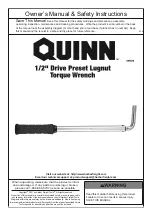
GB
11
through the opening in the worktop and can be
removed when you lift the equipment.
Clean the blade flange thoroughly before fitting
the new blade.
Mount and fasten the new saw blade in reverse
order.
Important.
Check that the saw blade turns in the
correct direction. The cutting direction of the teeth
must point in running direction, i.e. upwards. Refer to
the directional arrow on the saw blade cover and the
saw blade. Make sure the power plug is disconnected
and check if the new saw blade moves freely. Always
check to make sure that all safety devices are
properly mounted and in good working condition
before you begin working with the saw again.
7.4 Transport and storage (Fig. 8)
Use only the transport devices to move the
equipment. Never use the guards for handling or
moving the equipment.
Lock the equipment with the knurled handle (4)
and carry the equipment by the handle (6) or the
machine table (12).
Store the equipment in a dry room b5°C
and +40°C.
8. Operation
Important!!
After every new adjustment we recommend you
to make a trial cut in order to check the new
settings.
After switching on the saw, wait for the blade to
reach its maximum speed of rotation before
commencing with the cut.
Take extra care when starting the cut!
8.1 ON/OFF switch (Fig. 14-15)
To turn the saw on, press the green button “I” .
To turn the equipment off again, press the red
button “0”.
Your panel saw is equipped with an overload cut-
out switch. The overload cut-out switch
disconnects the power supply if the saw blade is
jammed or blocked. The switch unlocks
automatically after a certain period and can not
be reset manually.
8.2 Cutting narrow workpieces (Fig. 19)
Be sure
to use a push stick (14) when making
longitudinal cuts in workpieces smaller than 120 mm
in width. A push stick is supplied with the saw.
Replace a worn or damaged push stick
immediately.
8.3 Cutting very narrow workpieces (Fig. 20)
Be sure to use a push block (a) when making
longitudinal cuts in very narrow workpieces with a
width of 30 mm and less.
There is no push block supplied with the
saw!
(Available from your specialist dealer)
Please the push block without delay when it
becomes worn.
8.4 Making longitudinal cuts (Fig. 8, 16-20)
Use the knurled handle to lock the motor unit in
splitting position; this will release the safety lever.
Set the parallel stop (23) to the required width
and lock into position with the locking screw (24).
Remove the workpiece clamping device (5) and
the angle stop (10) so that the workpiece lies flat
on the work table.
The distance markings on the table are intended
only as a rough guide to the dimensions. First, cut
a test piece and reset if necessary.
Switch on the equipment and wait for a few
seconds for the equipment to reach its full
operating speed.
Push the workpiece through under the saw blade
cover (16). Place your hands (with fingers closed)
flat on the workpiece and push the workpiece
along the parallel stop (23) to the saw blade.
Push the workpiece on the left side using your left
hand, however only as far as the front edge of the
saw blade guard.
Always push the workpiece through to the end of
the splitter.
Always leave the offcuts on the saw table until the
saw blade has come to a complete standstill.
Always use the push stick (11) when your hands
come to within a distance of 125 mm from the
saw blade. After use, return the push stick (11) to
its mount.
8.5 Making cross cuts, angle -10°... +45°
(Fig. 8, 17, 21-23)
Remove the locking screw (24) of the parallel
stop (23) and remove the parallel stop (23) so
that the wood can lie flat on the table.
Always carry out cross cuts with the angle stop
(10) and the workpiece clamping device (5).
Set the angle stop (10) to the required angle and
secure the angle stop and the workpiece with the
workpiece clamping device (5). When the angle
Anleitung_BT_UP_470_SPK7:_ 10.06.2010 8:09 Uhr Seite 11


































